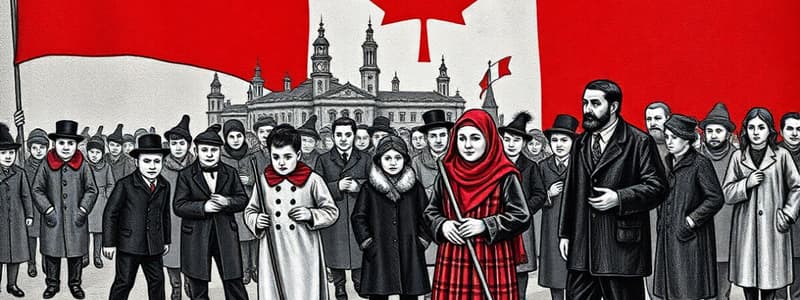Podcast
Questions and Answers
What is a common sentiment about Canada’s diversity as expressed by the Prime Minister?
What is a common sentiment about Canada’s diversity as expressed by the Prime Minister?
- Diversity is irrelevant.
- Diversity should be limited.
- Diversity is a hindrance to progress.
- Diversity is essential to Canada’s success. (correct)
Canada has always fully embraced immigration without any exclusions.
Canada has always fully embraced immigration without any exclusions.
False (B)
Name one ethnic group that faced exclusion in Canada's history.
Name one ethnic group that faced exclusion in Canada's history.
Chinese
According to a recent study, __% of Canadians hold negative views towards at least one specific ethnic group.
According to a recent study, __% of Canadians hold negative views towards at least one specific ethnic group.
Which group experienced a 253% increase in hate crimes from 2015 to 2019?
Which group experienced a 253% increase in hate crimes from 2015 to 2019?
Match the year with the corresponding excluded group:
Match the year with the corresponding excluded group:
Hate crimes reported to police in Canada reached a record-high in 2020.
Hate crimes reported to police in Canada reached a record-high in 2020.
What was the number of hate crimes reported to police in Canada in 2020?
What was the number of hate crimes reported to police in Canada in 2020?
What was the purpose of the Chinese Immigration Act of 1885?
What was the purpose of the Chinese Immigration Act of 1885?
No other ethnic group in Canada had to pay a head tax at the time the Chinese Immigration Act was passed.
No other ethnic group in Canada had to pay a head tax at the time the Chinese Immigration Act was passed.
What was the impact of the Chinese Exclusion Act of 1923 on the Chinese-Canadian population?
What was the impact of the Chinese Exclusion Act of 1923 on the Chinese-Canadian population?
The head tax for Chinese immigrants was set at ______ in 1885.
The head tax for Chinese immigrants was set at ______ in 1885.
Match the immigration policies with their impacts:
Match the immigration policies with their impacts:
What was a consequence of the Chinese Exclusion Act on family life?
What was a consequence of the Chinese Exclusion Act on family life?
During the time of WWII, Canadian authorities welcomed all immigrants equally, without any discrimination.
During the time of WWII, Canadian authorities welcomed all immigrants equally, without any discrimination.
What type of immigrants were Canadian authorities particularly discouraging during the late 19th and early 20th centuries?
What type of immigrants were Canadian authorities particularly discouraging during the late 19th and early 20th centuries?
Which groups were considered more desirable for immigration to Canada?
Which groups were considered more desirable for immigration to Canada?
The Canadian government openly prohibited Chinese immigration from the start.
The Canadian government openly prohibited Chinese immigration from the start.
What clause was included in the immigration act as a measure against Black immigrants in 1912?
What clause was included in the immigration act as a measure against Black immigrants in 1912?
The only group specifically distinguished by religion and culture at the bottom of the immigration list were __________.
The only group specifically distinguished by religion and culture at the bottom of the immigration list were __________.
Match the following immigrant groups with their perceived desirability:
Match the following immigrant groups with their perceived desirability:
Who stated that Black settlers were hoped to find the climate unsuitable?
Who stated that Black settlers were hoped to find the climate unsuitable?
By 1953, the immigration act contained specific provisions against Black immigrants.
By 1953, the immigration act contained specific provisions against Black immigrants.
What was the public perception about immigrants from tropical areas moving to Canada?
What was the public perception about immigrants from tropical areas moving to Canada?
Flashcards
Xenophobia
Xenophobia
The belief that immigrants are a threat to the existing culture and society.
Hate Crime
Hate Crime
An act against a person or group based on prejudice or hatred towards their race, ethnicity, religion, sexual orientation, or disability.
Immigration Exclusion
Immigration Exclusion
The process of excluding or rejecting immigrants based on their national origin, ethnicity, or religion.
Inclusivity
Inclusivity
Signup and view all the flashcards
Maclean's Magazine Study
Maclean's Magazine Study
Signup and view all the flashcards
Newer Immigrant Bias
Newer Immigrant Bias
Signup and view all the flashcards
Hate Crimes Against Muslims
Hate Crimes Against Muslims
Signup and view all the flashcards
Post-Confederation Immigration
Post-Confederation Immigration
Signup and view all the flashcards
Canadian Immigration's 'Unofficial' Barriers for Blacks
Canadian Immigration's 'Unofficial' Barriers for Blacks
Signup and view all the flashcards
The 'Climate Clause' of Canadian Immigration
The 'Climate Clause' of Canadian Immigration
Signup and view all the flashcards
Years of 'Unofficial' Barriers for Black Immigration
Years of 'Unofficial' Barriers for Black Immigration
Signup and view all the flashcards
Using American Postmasters to Identify Potential Black Immigrants
Using American Postmasters to Identify Potential Black Immigrants
Signup and view all the flashcards
The 'Climate Clause' as a 'Clumsy' Way to Curb Black Immigration
The 'Climate Clause' as a 'Clumsy' Way to Curb Black Immigration
Signup and view all the flashcards
1953: The Year of Change for Black Immigration
1953: The Year of Change for Black Immigration
Signup and view all the flashcards
Canada's Policy towards Chinese Immigration (1885 - 1947)
Canada's Policy towards Chinese Immigration (1885 - 1947)
Signup and view all the flashcards
Building the Country, Breaking Family Bonds: The Chinese Experience
Building the Country, Breaking Family Bonds: The Chinese Experience
Signup and view all the flashcards
Chinese Head Tax
Chinese Head Tax
Signup and view all the flashcards
Chinese Exclusion Act
Chinese Exclusion Act
Signup and view all the flashcards
Populate the West
Populate the West
Signup and view all the flashcards
Preference for White Immigrants
Preference for White Immigrants
Signup and view all the flashcards
Immigration Hysteria
Immigration Hysteria
Signup and view all the flashcards
Foreign Military Service
Foreign Military Service
Signup and view all the flashcards
Disrupting Family Life
Disrupting Family Life
Signup and view all the flashcards
Stunting Community Growth
Stunting Community Growth
Signup and view all the flashcards
Study Notes
Immigration and Exclusion in Canada
-
Canada promotes diversity as a source of strength, culturally, politically, and economically
-
Canada has a history of excluding immigrants based on their ethnicity, religion, or perceived suitability
-
Xenophobia has been codified in law against various groups; examples include the Irish (1847), Chinese (1885), Sikhs (1914), Jews (1939), Japanese (1940s) and Haitians (1973), reflecting a long-standing bias and exclusionary trends
-
A large portion of Canadians hold negative views towards specific ethnic groups, especially against recent immigrants
-
Hate crimes against Muslims have increased significantly, reaching a record high in 2020
Historical Barriers to Immigration
- Canada initially welcomed immigrants but faced internal issues of discrimination and exclusion against Black immigrants (1869-1953)
- The climate clause in immigration acts was used to exclude non-white immigrants, though it was not explicitly racist
- For Black immigrants, immigration authorities struggled to determine race without openly targeting them in discriminatory actions
- The Chinese were subject to a head tax, eventually leading to exclusionary policies to prevent immigration from China (1885-1947)
- Immigration policies were based on race and perceived assimilability, particularly favoring people from western European countries
Growth of Multiculturalism
- Canada's immigration policies started shifting away from racial categories and towards individual merits in the 1960s
- The number of non-European immigrants increased significantly, making it a multiracial and multicultural society
Studying That Suits You
Use AI to generate personalized quizzes and flashcards to suit your learning preferences.




